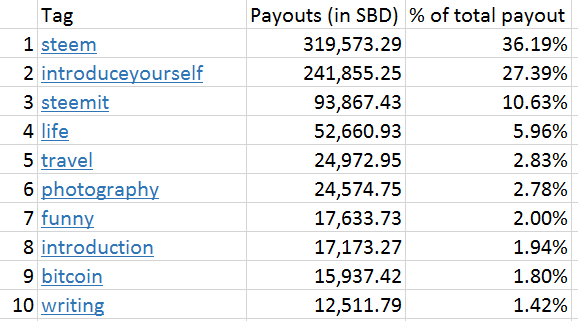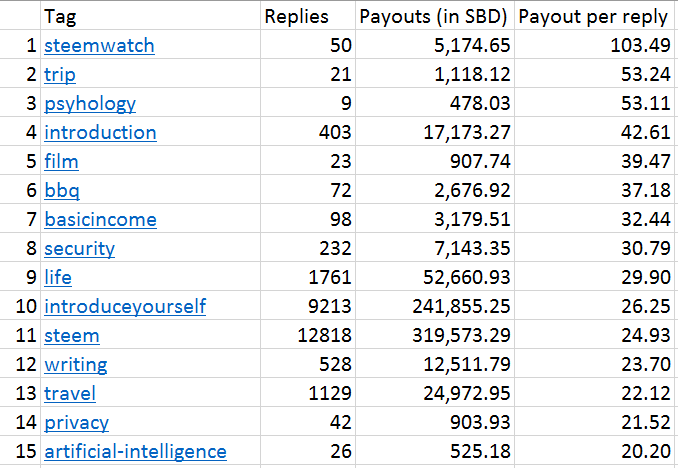
Ever wondered which Steemit topic tags are most lucrative, and why?
Wonder no more.
For my own curiosity, and because an excellent post by @rok-sivante got me thinking about topic tags, I decided to analyze the information available in the summary tab that appears when you click “Show more topics…” at the bottom of the Steemit Tags and Topics listing.
As of July 15th, 2016, here’s what I found — and the implications for the platform go way beyond what I expected.
Money Kings – highest overall payouts
The total amount of Steem Dollars (SBD) paid out across all the categories analyzed was 883,107.67. With that in mind, here are the top ten Steemit tags by payout:

With only a glance, it becomes apparent that Steemit wealth generation is concentrated in just a few topics: steem and introduceyourself account for the lion’s share of payouts.
Extending the analysis to the full list of topics analyzed (the top 100) is even more telling:

There are a few different ways of considering this information. Three tags generating nearly three-quarters of all payout wealth seems to imply that if you want to maximize the chance of monetizing your posts, you should post in those topics. But some information is missing – namely, the number of posts vs. the value of the payouts.
Moneytags – highest payouts on an adjusted basis
Since I didn’t find an easy way to mass-analyze the number of posts within each topic, or the number of votes on those posts, as a proxy of user interest I used the number of replies, which is available on the same page as the total payouts.
Examined in this way, the data changes significantly:

When taking into account the average payout per reply, the two Money King categories introduceyourself and steem are no longer dominant. They still rank within the top fifteen of what I call the Moneytags, but this more diversified ranking shows that you’re not necessarily punishing yourself by branching out to try other topics. Traditional blog topics like travel and life start to do very well when analyzed on a per-reply basis. Even more arcane topics like artificial-intelligence creep into the list, showing much higher returns than the 7.96 average return per reply across all tags.
One interesting outlier is psyhology (sic), which is third on the list in payout-per-reply despite not even being spelled correctly. Because the number of replies is low, on the surface it seems probable that psyhology’s outperformance is an anomaly not truly indicative of a lucrative tag; a deeper dive bears out that assumption, showing that a single post within the topic accounts for more than half of its earnings.
Hang on – doesn’t the list look weird?
The most telling result of the analysis is that topics with steem anywhere in the title (steem, steemit, steemwatch, etc.) collectively make up 47.77% of all payouts to date.
To understand the implications of that finding, take yourself out of the context of Steem for a moment and consider other social media platforms. If you went to Facebook and found that half of all Facebook monetization was tied to posts discussing Facebook, that would probably strike you as odd.
It’s odd here as well.
Isn’t this bad? What does it all mean?
Only 100 topic tags are listed on the tag page. Lower-producing tags get cut off the list. As of the morning of July 15, 2016, one third of the 100 listed tags had produced zero earnings. That's a powerful indicator that discussion on the site is dangerously narrow.
That the bottom 50 (fully half) of listed tags account for less than 0.005% of total payout is even more disturbing. It’s also in strong violation of the Pareto principle (or the 80-20 rule), which states that for many events and situations, 80% of effects come from 20% of causes. In the case of Steemit, if the effect being analyzed is wealth generation, 98.03% of the effect is coming from less than 20% of the causes, which is unsustainable over the long term. If we knew exactly how many total tags there are — of which the vast majority have generated zero wealth — the picture looks worse.
Right now, Steemit is less of a social media platform and more of a platform to talk about Steem. In terms of both interest levels and payouts, if you’re on Steemit and you’re not talking about Steem, chances are good that you’re striking out into uncharted territory.
The shining light
The deeper we look at the numbers, the more negative it starts to feel. But that might be misleading. There’s room for strong optimism that Steemit is adjusting, and the justification for that optimism is the Moneytags analysis.
Although it seems like everyone and their dog, and their grandmother’s dog, is talking about Steem and Steemit instead of using Steemit to talk about other things, the widely varied topics in the top 15 Moneytags arguably show huge potential for growth and user hunger for different content. Steemit is deeply immature as a platform, so right now everybody that finds it jumps right into introduceyourself and then starts talking about how they got involved with Steem. As the user base stabilizes into a less exponential growth curve, there should naturally be less of a content imbalance toward topics aimed at — and created by — brand new users.
Further evidence of this branching topic structure shows through in a repeat of this whole exercise performed later in the evening of July 15th. Within just a few hours, the number of tags that had generated at least some amount of revenue grew from 65 to 68 compared to the analysis done on the morning of the 15th.
Be the change you want to see
If it seems like we got a bit away from the initial premise of the discussion, that’s because the discussion turned out to be so interesting (to me…). Sorry!
The conclusion to draw about the easiest path to jumping into lucrative posting on Steemit is clear: by far the most popular categories, which are also among the most profitable individually, are Steem itself, how you found it, and why you like it.
But over the long term, the situation will need to reverse to achieve sustainability. Rather than treading the same ground of self-introduction -> Steem -> Steemit -> Steem -> Steemit to infinity, the future of the platform will be decided by those who create the most unique content and drive traffic toward new and different tags with higher payout ratios.
Instead of seeking the tags with highest current payout ratio to post under, seek to understand how those ratios came about; namely, that there has been a hidden rush on to find something new and different on Steemit. A person can only read so many random introductions and stories about how Steem is going to change the world. At some point, interest shifts, and we could be seeing that point now in the high relative value of topics like writing and life.
Whales can exert an outsized effect on the Steemit trends, and more than any other individuals it is up to them to start us down the path to improved posting diversity. Some up-and-coming, newly influential users have already begun, like @stellabelle engaging directly with the community with her Secret Writer series and musings on wildly varying subject matter, and @heiditravels with her travelblogs.
For the future health of the platform, and your Steem wallets, I encourage all of you to be like them: don’t just follow.
LEAD.
Help create the Steemit — and world — that we all want to see.
Wow! This is great information for people like me who are just starting! Thank you for sharing this! Very helpful! :) is it possible to change tags after you have published something?
Great compharsion I hope to make it usefull for me :)
I came to steemit to write content on anything that will make me some money
What I need is a tag earnings divided by posts - i.e. what is the average earnings of a tagged post - a payout per post, rather than a payout per reply
I realize multi-tagged posts will skew the numbers, but I'd readily accept that